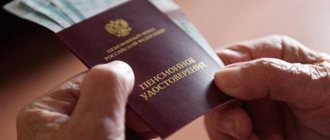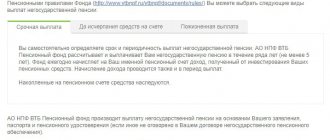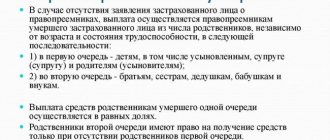- home
- Reference
- Funded pension
As a result of the large-scale pension reform that took place in our country in 2002, the concept of the funded part of the pension was introduced. Thus, all citizens who were born in 1967 and later could independently decide how to determine savings for their future pension - transfer funds in full to the insurance part or create a funded one together with the insurance one.
During this time, millions of Russian citizens of working age entered into agreements with dozens of non-state pension funds in hopes of receiving a decent pension in the future. However, in 2014, the state decides to ban contributions to the funded part , the consequences of which are unclear for citizens and therefore, among other things, will be discussed further in this article.
What is freezing the funded portion of a pension?
To answer the question of what freezing a funded pension means, you must first acquire a basic understanding of how pensions are accumulated in accounts in the Pension Fund, which are registered for each citizen.
So, in accordance with the law, for each citizen engaged in labor activity, his employer contributes a certain amount of money, the so-called insurance contributions. Their size is individual for each employee, since it directly depends on the size of the official salary, amounting to 22% of it.
Reference! Persons who are registered in accordance with the law as individual entrepreneurs or are notaries or privately practicing lawyers are required to make contributions to the state pension fund independently.
If the employee decides that, in addition to the insurance, he also wants to form a funded part of the pension, then these contributions are distributed as follows: 16% for the insurance and 6% for the funded one.
Freezing the funded part means that temporarily all contributions are sent directly to the state pension fund. In other words, the money goes towards creating only an insurance pension.
Inheriting a pension
Unlike all previously assigned old-age payments, the funded part can be inherited. It is received by its heirs in accordance with the established procedure set out in Government Decree No. 711 of 07/30/2014. Cash savings can be inherited both by law and by will. A will is a statement that a citizen can draw up by sending it to the Pension Fund. In this case, all those indicated in this document are considered heirs. If such paper has not been drawn up, then the immediate relatives will receive money from the savings account in equal parts.
Government Decree N 711
An application for the payment of pension savings of a deceased insured person can be found here, and a form for an application from an insured person for the distribution of pension savings between the specified legal successors can be found here.
You can claim an inheritance in the following cases:
- upon the death of the recipient of the funded part of the payment before the date of its first receipt. As soon as the first cash payment from this account occurs, the heirs will no longer be able to claim a funded pension. The entire balance goes to the Pension Fund for payments to other pensioners;
- when assigning but not receiving a lump sum payment;
- if an urgent payment has been issued, but its amount has not been received in full.
Important! You can receive savings money as an inheritance only after one of the heirs submits an application. Such payments are not automatic, even if a preliminary will has been drawn up with the Pension Fund. The application must be made within 6 months of the date of death. Payments are made after six months to all applicants who have grounds for receiving an inheritance. The money will be credited to the heirs’ accounts no later than the 20th day of the month following the day when the decision on inheritance was made.
You can receive savings money as an inheritance only after one of the heirs submits an application
If the inheritance has already occurred and another heir has applied to the Pension Fund of Russia, then there will be no correction of the funds previously received by the legal successors. The new applicant will receive an inherited portion from the reserve fund.
What the law says
Issues that are directly related to the formation of pension savings and, accordingly, to the freezing of the funded portion are subject to strict legal regulation.
Thus, this moratorium was introduced by Federal Law of December 4, 2013 No. 351-FZ . It was then assumed that this measure would be temporary, transitory in nature, and therefore the ban was extended only for one year. However, subsequently, by separate federal laws, the moratorium on the deduction of funds for the funded part of the pension was repeatedly extended annually.
At the end of 2021, Federal Law No. 462-FZ of December 11, 2018 came into force, according to the provisions of which the ban in question was extended until 2021, inclusive.
Attention! There is reason to believe that this ban will be extended beyond 2021, since, for example, representatives of the Ministry of Finance at the official level declare the need to extend this period until 2022.
Left without payments
In 2021, according to data from the 15 largest non-state funds (NPF), almost 2.1 million Russians did not apply for payment of a funded pension. However, in 2021 the number of such citizens was significantly smaller: 1.6 million people. The funds linked this situation to a number of factors. Including outdated databases, difficulties when submitting an application, as well as insufficient information to the population.
Among those who did not take the money in 2021 were 200–400 thousand Russians who received a lump sum payment. Taking this into account, on average 1.7–1.9 million people were left completely without a funded pension.
The funded part of the pension from employer insurance contributions has been temporarily frozen since 2014 until 2023. All contributions go towards the insurance part of the old-age pension. The existing savings continue to be invested - they can be received upon retirement.
From January 1, 2021, the period used to calculate the funded pension is 264 months. The corresponding law was signed in December last year.
Photo: Moscow 24/Mikhail Sipko
What goals does the government pursue?
The moratorium is a decision that cannot be taken positively. The losers from this are both ordinary citizens who decided to form the funded part of their pension, and non-state pension funds. Many of them, in fact, found themselves on the verge of bankruptcy as a result of this ban.
Initially, when the ban was introduced for the first time, the Government of the Russian Federation stated that the reason for this was the need to check the activities of certain non-state pension funds due to the latter’s failure to comply with a number of provisions of federal legislation.
However, many analysts believed that the real reason for making such an unpopular and painful decision was the shortage of funds from the Pension Fund. It is known that for many years the state pension fund did not have enough of its own funds to fulfill social obligations to pensioners. In this regard, funds for these purposes were sought from third-party sources. However, for demographic reasons, this deficit tended to gradually increase.
In 2014, the Russian economy entered a period of systemic crisis caused by both internal and external political reasons, the consequences of which are still felt today.
In this regard, in order to avoid the collapse of the pension system, the Government decided to temporarily stop the formation of this type of pension.
In addition, to ensure the stability of the Pension Fund, the state took the following series of unpopular measures during the same periods:
- termination of the annual indexation of pension payments to working pensioners;
- indexation of pensions for non-working pensioners in an amount significantly lower than predicted and actual inflation;
- making a decision to increase the retirement age.
Example
The longer the expected period, the smaller the pension. Here's an example:
A citizen has pension savings in the amount of 240,000 rubles.
Upon retirement in 2021, the size of his funded pension will be 240,000/240=1000 rubles. per month.Upon retirement in 2021, the amount of his funded pension will be 240,000/246 = 975.61 rubles. per month.
Upon retirement in 2021, the amount of his funded pension will be 246,000/252 = 952.38 rubles. per month.
How will the freeze affect the size of future pensions?
Undoubtedly, the fact that a moratorium has been imposed on the formation of funded pensions in the country has an extremely negative impact on the pension expectations of citizens. In this regard, many future pensioners suffered certain losses due to the fact that investment income from the management of their funds was simply lost.
The reason for this, among other things, is that many non-state pension funds, whose main activity is the accumulation of funds received from insurance premiums and investing them in profitable projects, have simply declared themselves bankrupt.
Experts note that this moratorium has even greater and longer-term consequences . Thus, it was determined that NPFs almost completely stopped investment activities, which contributed to the slowdown in economic growth in the country as a whole.
Many citizens who have agreements with non-state pension funds are concerned about the future of the current funded pension model. It is still difficult to answer, but the Ministry of Finance of the Russian Federation is already developing changes.
Thus, according to the projects proposed for consideration by the Government, the funded pension will continue to exist, but this will happen within the framework of the formation of the so-called individual pension capital (IPC).
Important! This term should not be confused with the individual pension coefficient (also IPC), which is used to calculate the insurance pension and expresses the volume of accumulated pension rights.
It is assumed that citizens interested in the formation of this type of pension savings will be required to independently pay funds to the non-state pension fund of their choice. The same 22% of the salary that the employer contributes to compulsory pension insurance will go entirely to the insurance part or, simply put, will be used to fulfill the current obligations of the pension fund.
The moratorium discussed in this article was first introduced in 2014 against the background of a significant deterioration in the state of the Russian economy and in order to prevent the collapse of the pension system due to the growing deficit of the Pension Fund. Despite the fact that in 2016 the main difficulties were overcome, the moratorium was extended until 2021, and later until 2021 inclusive. At the moment, there is no reason to believe that the Government and the Pension Fund will return to the pre-crisis model of forming pension savings.
Changes in funded pensions in 2021
The innovations regarding the age threshold at which it becomes possible to apply for a pension have not affected the procedure for applying for a funded pension and remain in the same form, but the period used in its calculation has changed - 252 months.
Let us note that, despite the adopted innovations in pension legislation, persons who form their pension savings assets are authorized to demand their payment, as before - from 55 and 60 years of age (women and men).
Claiming to receive pension savings assets is permitted upon reaching a specified age, subject to the requirements for assigning an old-age insurance pension (required work experience and number of pension coefficients). If you encounter difficulties related to funded pension provision, you can consult with our specialists.
- Consultation with qualified lawyers
Potential reforms in the funded pension program
Experts say that the program for the funded part of pension payments has not at all lived up to the hopes placed on it. In this regard, the decision to extend the lockdown until next year became inevitable. Deputies and ministers are already developing projects for new changes to the pension system. The new program will be called personal pension savings. He is obliged to completely change the program for the funded part of pension savings. Currently, the executive branch is thinking through the main points of the planned project. The main difference between the existing program and the planned one is the structure of payments. Currently, the funds allocated to both the insurance part and the savings part are contributed by the employer. In the situation with individual pension capital, they want to change this order, i.e. all twenty-two percent must be transferred to a deposit in the Pension Fund as a payment for the insurance part of pension savings. The employee will be required to create the savings portion directly. Such a proposal provides for the opportunity to transfer up to six percent of earnings to IPC. Moreover, the funds will be deducted from the employee’s earnings. According to the ministers’ plan, personal income tax will not be charged on transfers from individual industrial complexes. If a citizen resorts to this option, then initially a share of finances will be deducted from earnings as contributions to the IPC. The rest of your earnings are already subject to a tax levy. Additionally, the mechanism for triggering this feature is still under discussion. Ministers propose to enable it by default for each employee and give them the right to refuse when submitting an appropriate request. The Ministry of Labor does not agree: the government body believes that the employee must write an appeal himself if he wants to launch an IPC.
How freezing funded pensions will hit Russians
In developed countries, a person is guaranteed that upon retirement, the amount of payments will reach no less than 40% of the average salary. A similar standard is regulated by Convention 102 of the International Labor Organization introduced in Geneva. This document was adopted back in 1952.
As for Russia, it joined the ILO Conventions only a few years ago. Meanwhile, the replacement rate is only 30%. Moreover, the indicator does not increase, but, on the contrary, decreases. This trend is caused primarily by a series of economic crises.
The funded part of pensions in the Russian Federation has been introduced since 2002. The initiators of this innovation insisted that the savings component would allow it to almost double over time. According to 2013 data, over 79 million people were involved in the savings system.
The total amount of funds generated in the savings system exceeded 2.8 trillion rubles. Meanwhile, a decision was subsequently made to introduce a moratorium on the funded part of the pension, which was initially intended to be a purely temporary measure.








